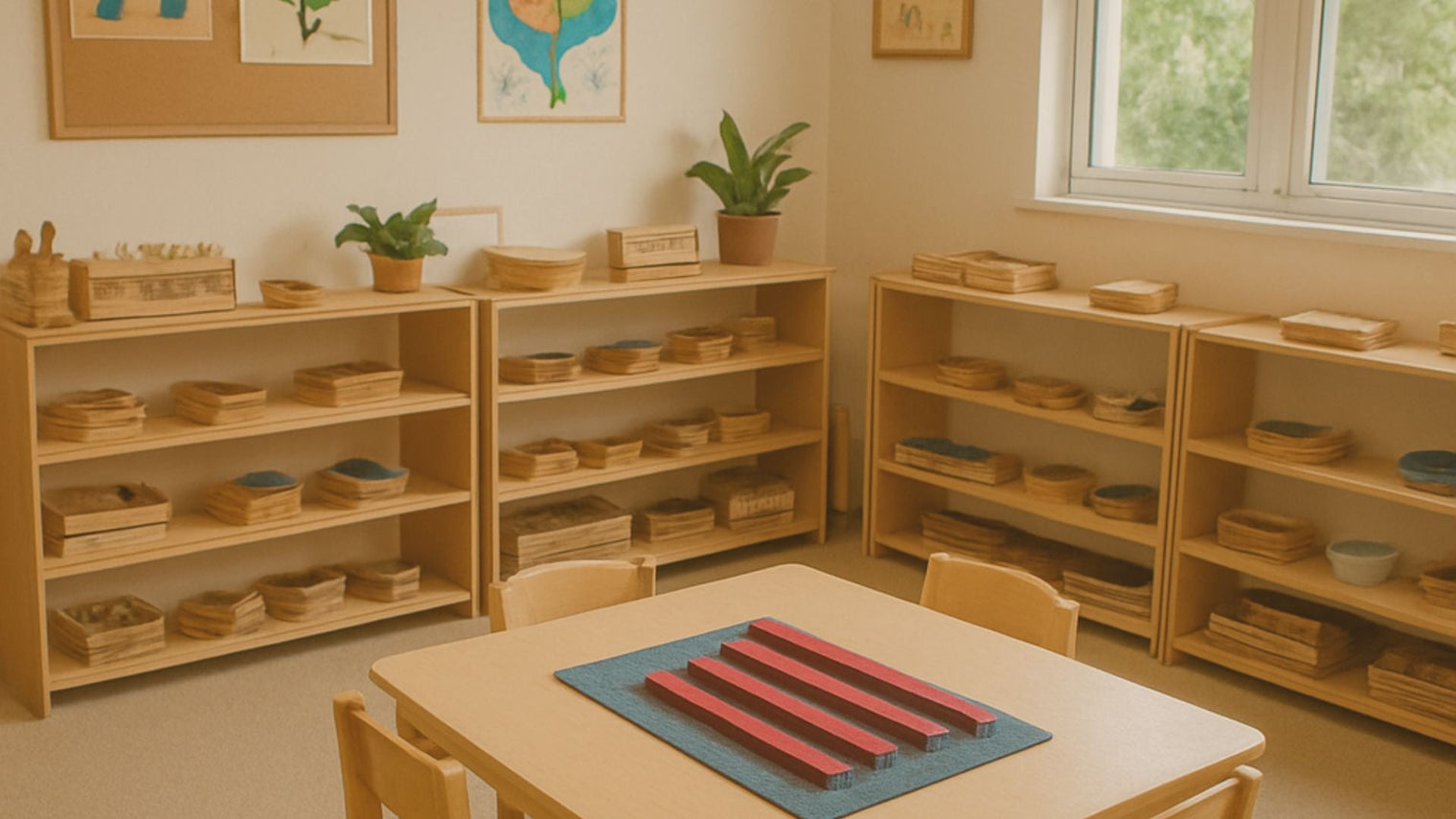Welcome to Dannico Woodworks, where quality meets innovation in children's furniture!
As parents, we’ve all seen it — the overflowing toy bins, the scattered blocks, and the endless clean-up routines that seem to take over the day.
Kids lose interest quickly when they have too many choices, leading to cluttered spaces and overstimulated minds.
But what if you could create a calmer, more intentional play environment that sparks curiosity and focus?
That’s exactly what a Montessori toy rotation system helps you achieve. This simple yet powerful method encourages children to explore deeply, engage meaningfully, and develop independence — all while keeping your home organized and peaceful.
Let’s walk through how you can set up a Montessori-inspired toy rotation system in your home and how thoughtfully designed furniture from Dannico Woodworks can make the process even smoother.

Developed by Dr. Maria Montessori, this educational approach emphasizes independence, hands-on learning, and respect for a child’s natural psychological development.
Central to this philosophy is the idea of a prepared environment—a space where everything is arranged to encourage children to explore and learn independently.
What is a Toy Rotation System?
A toy rotation system involves regularly changing the selection of toys that are accessible to your child.
Instead of having every toy available at once, you rotate them, offering a fresh selection every few weeks.
This approach helps maintain a clutter-free environment and keeps children engaged without feeling overwhelmed.
Benefits of Toy Rotation
- Encourages Focus and Engagement: With fewer toys available, children can focus more deeply on each one, leading to more meaningful play.
- Reduces Overwhelm: A clutter-free environment helps children feel calm and reduces stress.
- Promotes Independence: Children learn to choose and explore toys independently when they are presented with a limited selection.
- Sparks Creativity: Rotating toys regularly keeps playtime exciting and encourages creative thinking.
Setting Up Your Montessori Toy Rotation System
Step 1: Assess Your Toys
Start by reviewing all the toys you currently have. Sort them into categories such as educational toys, sensory toys, building blocks, puzzles, and imaginative play items.
This will help you understand what types of toys your child enjoys and which ones they might need more of.
Step 2: Create a Storage System

Ensure that these storage solutions are easily accessible when it’s time to swap toys.
Step 3: Select a Rotation Schedule
Decide how often you want to rotate the toys. Many parents find that every two weeks works well, but you can adjust this based on your child's interest levels.
The key is to keep the rotation frequent enough to maintain interest but not so frequent that it becomes a chore.
Step 4: Choose a Selection of Toys
For each rotation, select a balanced mix of toys. Include a variety of Montessori learning tools, such as puzzles for problem-solving, building blocks for creativity, and books for literacy development.
Aim for about 6-8 different toys in each rotation, depending on your child's age and interests.
Step 5: Arrange the Toys
Arrange the selected toys on low shelves within your child's reach. The idea is to create an inviting space where your child can easily choose and return toys without assistance. Ensure that the display is neat and uncluttered, with plenty of space for each toy.
Step 6: Observe and Adjust
As you implement your toy rotation system, observe your child’s interactions with the toy.
Take note of which toys capture their interest and which ones are ignored.
Use this information to adjust future rotations, ensuring that the selection remains engaging and relevant to your child's developmental stage.
Tips for a Successful Toy Rotation
- Involve Your Child: Encourage your child to help select toys for the rotation. This involvement gives them a sense of ownership and responsibility.
- Keep It Simple: Avoid overcomplicating the system. The goal is to create a stress-free and enjoyable experience for both you and your child.
- Be Flexible: If your child is particularly attached to a toy, allow it to stay in the rotation longer. The system should work for your family, not against it.
- Regularly Review Toys: As your child grows, their interests and developmental needs will change. Regularly assess your toy collection and update it as needed.
Incorporating Montessori Learning Tools
Montessori learning tools are designed to support your child's development in a hands-on, interactive way. When selecting toys for your rotation, consider including some of these tools to enhance the learning experience:
- Practical Life Tools: Child-sized kitchen utensils, cleaning tools, and gardening kits help children develop life skills and foster independence.
- Sensory Materials: Items like texture boards, musical instruments, and scent jars engage the senses and promote exploration.
- Mathematics Materials: Counting beads, number rods, and fraction circles tangibly introduce mathematical concepts.
- Language Materials: Alphabet puzzles, word cards, and storytelling kits encourage language development and literacy skills.
Practical Tips for Success
-
Quality Over Quantity: Invest in durable, open-ended toys that grow with your child.
-
Aesthetic Matters: Montessori spaces are calm and beautiful. Choose natural materials like wood over plastic when possible.
-
Child Involvement: Let your child help organize and decide what to display — it builds confidence and respect for their space.
-
Consistency: Keep your rotation area neat and predictable so your child feels secure and in control.
How Dannico Woodworks Supports Your Montessori Journey
At Dannico Woodworks, we understand the importance of designing spaces that encourage independence and creativity.
Our handcrafted Montessori-inspired furniture, such as the Montessori Bookshelf Collection, is built to grow with your child — durable, safe, and beautifully minimalist.
Each piece is designed with child development in mind:
-
Low, open shelves for easy access
-
Rounded edges for safety
-
Sustainably sourced materials for a natural aesthetic
-
Timeless craftsmanship that blends seamlessly into your home
When paired with a toy rotation system, these features help create a learning environment that’s both functional and inspiring — one that nurtures independence while reducing household chaos.
FAQs
How often should I rotate toys?
Every 2–3 weeks is a good starting point. Observe your child’s engagement — when they lose interest, it’s time for a change.
Can I rotate books too?
Absolutely. Rotating books every few weeks helps keep storytime exciting and encourages a love for reading.
A Montessori bookshelf is perfect for displaying books face-out, making it easy for little ones to choose their next read.
What if my child wants all their toys at once?
That’s normal! Try involving them in choosing which toys to display. Over time, they’ll enjoy the simplicity and focus of fewer options.
Is toy rotation suitable for toddlers?
Yes. In fact, toddlers benefit the most because they’re developing concentration, motor skills, and independence.
Conclusion
Implementing a Montessori toy rotation system is more than just an organizational strategy — it’s a lifestyle shift toward intentional, mindful parenting.
It helps your child build focus, independence, and a deeper connection to their environment.
At Dannico Woodworks, we’re proud to be part of that journey, crafting furniture that supports the Montessori philosophy and empowers families to create beautiful, functional spaces for their children.
So, are you ready to simplify your playroom and nurture your child’s natural curiosity? Explore our Montessori Bookshelf Collection and start building a space that inspires growth, independence, and joy.

